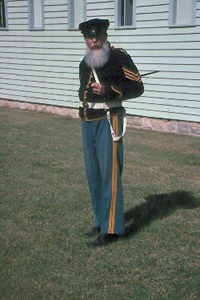
NPS Organizing an ArmyWithout effective leadership, discipline, and training, an army would not be prepared to perform its duties. The army’s command structure helped to bring about this discipline. Structuring the CompanyThe basic unit of command was the company. Ten companies made up a regiment, and two to five regiments made up a brigade. A company of soldiers consisted of about 60 men, which included 48 privates, four corporals, four sergeants. Each company was commanded by a first and second lieutenant, and a captain. Privates were organized into four squads with each squad being commanded by a corporal and a sergeant. This is reflected through the arrangement of the sleeping quarters. One squad occupied one row of bunks, with the corporal sleeping in the single beds at the end. Two squads occupied one squad bay. Commanding officers for each company lived in separate quarters but did maintain an office in the barracks in order to post daily assignments and to conduct routine business. The Role of Noncommissioned OfficersDiscipline was enforced by the noncommissioned officers (sergeants and corporals) under the direction of the commissioned officers (captains and lieutenants). It was also the noncommissioned officers that delivered the majority of the training to the soldiers. These noncommissioned officers were chosen from the best and most experienced enlisted men. These were men the officers felt could be relied on to act responsibly and to be able to handle the polyglot, many language, group under their command. Literacy often was a factor, for a noncommissioned officer who could read and fill out forms was an asset. Percival Lowe, who was with the 1st Dragoons from 1849-1854 and became a sergeant, prided himself on the fact that he could call the roll at "tattoo" without a list or lantern. His description of a fellow noncommissioned officer was that he was "a fine horseman, an excellent shot, a superior drill and all-around athlete," who would attract attention anywhere. Usually a certain resentment from the more unruly members of the company had to be overcome before a sergeant or corporal was well established. Lowe observed that men might be disciplined in garrison, but it was in the field, on the march, and in bivouac, where they were exposed to the storms, cold and heat, that the "thorough dragoon was made." Hardships had to be born cheerfully and a camaraderie was formed. A first year man was "not worth half as much as in after years." The latter observation, he felt, applied even to troops, where three-fourths of the men were old soldiers who had served more than one year. Experience more Life on the FrontierBack to Virtual Resource Center HomeDragoon Soldier PagesOverview | Program Outline | Tools of the Trade | Regulations | Historical Background | Recruitment | Training | Command Structure | Daily Life | Expeditions |
Last updated: May 23, 2022
